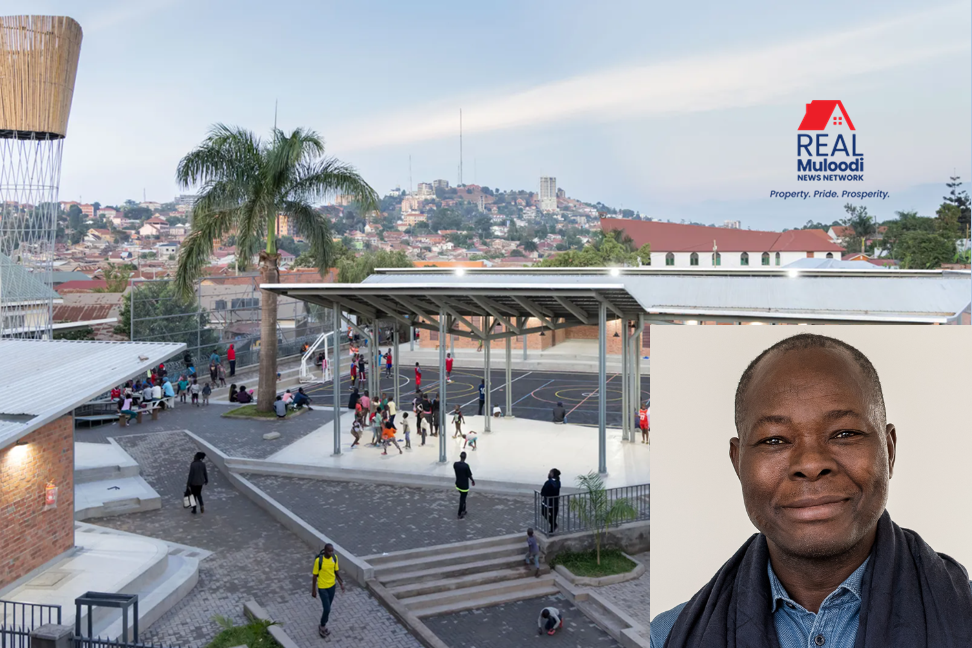UGANDA, Kampala | Real Muloodi News | What began as a simple idea to build a new playground in Kampala became “the place to be” for a neighbourhood-in-need once Pritzker Prize-winning architect Francis Kéré got involved.
The recently completed multipurpose community playground is nestled in the heart of Kamwokya, a poor urban district on the margins of Kampala city.
Officially inaugurated on October 14, 2022, the community carved out this pocket of public space from a thicket of dilapidated houses and zigzagging alleys. The Kamwokya community playground includes open-air areas for gathering, multipurpose rooms for workshops and night classes, a small gym, an internet café, a music studio, restrooms, and a multisport pitch.


Renowned architect Francis Kéré, who was awarded the Pritzker Prize for architecture this year, donated his design services for the project.
Kéré grew up in the remote village of Gando in Burkina Faso, where he developed his extraordinary sense for the pulse of communities. With the support of his family, he travelled to Germany in 1985 on a scholarship to study carpentry. He settled in Berlin soon after to pursue a degree in architecture.
While still a student in 2001, Kéré contributed a new primary school to his home village. With the help of neighbors and friends, he built the school by hand from clay-and-cement brick and sheet metal. That structure, and the many others in West Africa that have since followed, began with a dialogue with the local community. For Kéré, every commission starts with a conversation, and Kampala was no different.



“The key was being introduced to the community,” Kéré says of the project. Public meetings were convened in Kamwokya in 2016, and the local’s wish list for the playground quickly coalesced. “You have a diverse neighborhood,” he reflects. “You realize you don’t just build a community center. You are trying to create it depending on the residents’ needs.”
The complex took four years of planning and two years of construction, and the finished result is a fine-tuned piece of social infrastructure that affects local life at all levels.
The walls that enclose the complex are a blank canvas for local street artists who have already begun to leave their mark. The space, its multisport pitch in particular, nonetheless remains open, inviting, and inspiring.
“It’s the place to go now,” Kéré says with pride. “The kids want to play soccer at the national level!” Low-slung pavilions flank the field, all covered by his signature butterfly roofs. These sheet-metal canopies raised on delicate supports, provide a barrier against a punishing sun while improving ventilation (a tried-and-true, low-tech means of thermal comfort in a tropical climate).


On the west side of the pitch, a covered area offers shade for watching a match, resting, eating, or dancing. Across the field, a brick building houses spaces for learning and exercise.
Kamwokya Christian Caring Community, a local nonprofit partnered with Ameropa Foundation, will manage this site.
The palaver tree inspired Kéré’s hospitable architecture design. In West African communities such as his home village of Gando, villagers convene under the palaver to discuss public matters, do business, or socialize. The tree and its shade provide an essential architecture for village life: a place for everyone, with room for all. “A tree is a gathering space,” Kéré explains, offering in French, “un arbre à palabres.”

Even an architect as diligent as Kéré can be surprised by how people, especially children, use his work. “They take over and play games you never thought possible,” he says. For example, on a recent visit to the site, Andrea Maretto, an architect in Kéré’s practice, discovered local kids laughing, running, jumping and sliding across the building’s smooth terrazzo floors. “We were planning playgrounds for them,” Maretto notes. “But the simplest thing, a polished floor, that’s what they love the most.” To Kéré, it was gratifying. That ad hoc recreation was a sign they had begun to make this multipurpose playground in Kampala their own.

READ MORE LIKE THIS:



